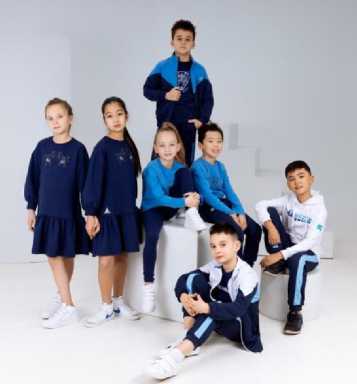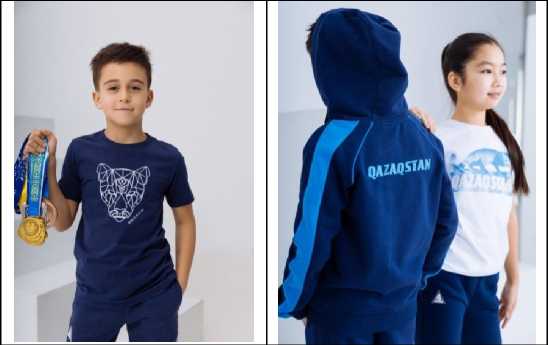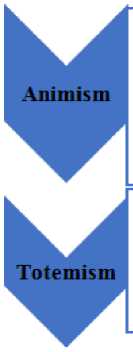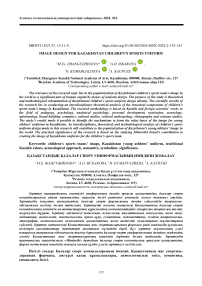Image design for Kazakhstan children’s sports uniform
Автор: Zhanguzhinova M.Ye., Iskakova A.O., Kumargaliyeva N., Kaupuzs A.
Журнал: Вестник Алматинского технологического университета @vestnik-atu
Рубрика: Технология текстиля и одежды, дизайн
Статья в выпуске: 2 (144), 2024 года.
Бесплатный доступ
The relevance of the research topic lies in the popularization of Kazakhstani children's sports team’s image in the world as a significant part of human capital by means of uniform design. The purpose of the study is theoretical and methodological substantiation of Kazakhstani children's sports uniform design identity. The scientific novelty of the research lies in conducting an interdisciplinary theoretical analysis of the structural components of children's sports team’s image in Kazakhstan. The research methodology is based on Kazakh and foreign scientists' works in the field of pedagogy, psychology, analytical psychology, personal development, motivation, acmeology, epistemology, brand building, semantics, cultural studies, cultural anthropology, ethnography and costume studies. The study’s results made it possible to identify the mechanisms to form the value bases of the image for young athletes’ uniforms in Kazakhstan. An interdisciplinary, theoretical, and methodological analysis of children's sports uniform design made in this research will contribute to the popularization of Kazakhstan's young athletes’ image in the world. The practical significance of the research is based on the studying Mimioriki brand’s contribution to creating the image of Kazakhstan uniforms for the children's sports team.
Children's sports teams’ image, kazakhstan young athletes’ uniform, traditional kazakh values, acmeological approach, semantics, symbolism, significance
Короткий адрес: https://sciup.org/140305877
IDR: 140305877 | УДК: 8.07.47, | DOI: 10.48184/2304-568X-2024-2-135-143
Текст научной статьи Image design for Kazakhstan children’s sports uniform
MRNTI 18.07.47, 15.31.31
The research topic reveals the actual aspects of Kazakhstan children's sports uniform design for the conceptualization of art history, cultural studies, education, ethnographic, technological, ergonomic, functional, and psycho-physiological approaches in clothing design. The problem of the study is the contribution of domestic conceptualists to the development of ideological and value bases of creating an image for Kazakhstan children's sports teams that have not been given due attention. The relevance of the study is determined by the growing interest of young people in sports and in the design of children's sports uniforms, which confirms the great consumer demand for Kazakhstan-made products. The object of the study is the uniform of Kazakhstan's young sportsmen, which reflects the visual characteristics of the sports team image. The subject of the study is an acmeological approach to image shaping of the Kazakhstan children's sports team in order to interpret its semantics through traditional Kazakh values. The purpose of the study is to determine the means to create the uniform of young sportsmen image, based on Kazakh traditional values. The task of the study is to form a scientific and pedagogical justification for the methods of children's sports team's image based on the Kazakhstan uniform project for the children's sports team from the Mimioriki brand. The study posits that through the conceptualization of the theoretical and methodological foundation for designing children's sports uniforms, the popularization of Kazakhstani brands by means of value guidelines will be updated. The aim of this research is to explore how traditional Kazakh values can be used to shape the image of the children's sports team in a way that reflects the cultural identity and values of the Kazakh people. Through an acmeological approach, the research will examine the unique characteristics of the children's sports team and identify ways in which these can be harnessed to create a powerful and effective image. The research will also explore how traditional Kazakh values can be used to motivate and inspire the team, helping them to achieve their full potential both on and off the field of sport.
Overall, this research contributes to the field of sports psychology and the study of human achievement, providing valuable insights into how traditional cultural values can be used to shape the image of sports teams and inspire their exceptional performance.
Materials and research methods
The theoretical and methodological basis of the study are the works of Kazakh and foreign scientists in the field of pedagogy, psychology, analytical psychology, personal development, motivation, acmeology, epistemology, brand creation, semantics, cultural studies, cultural anthropology, ethnography, and costume design studies.
The problem of scientific and theoretical study of local designers' contribution to the shaping of the image of children's sports teams in Kazakhstan covers:
-
• issues of development of ideological and value bases - concepts of collections of children's sports uniforms;
-
• the hypothesis of the study is that when conceptualizing the theoretical and methodological base for the design of children's sports uniforms, the popularization of Kazakhstani brands by means of value guidelines will be updated.
-
• the stages of the research are: conducting a cross-cultural review analysis, identifying the definitions of epistemological and analytical psychology (archetype theory), structuring the semiotic and hermeneutic components of the image concepts.
-
• the basis of the research are the following methods: scientific-theoretical, survey-culturological, epistemological, analytical psychology (the theory of archetypes), axiological, structural-semiotic, hermeneutical, cross-cultural analysis, semantic [1-4].
-
• the results of the study are based on the mechanisms of formation of the value bases of the image for the uniform of young athletes of Kazakhstan, based on the study of historical materialism and the semiotics of traditional values.
The study examines the practical experience of creating sportswear based on the project Mimioriki, the first Kazakh brand of children's clothing, developed by designer Maya Zhumanbekova.

Figure 1. The uniform of Kazakhstan children's sports team, brand “Mimioriki”, designer Maya Zhumanbekova
The image of the snow leopard “irbis” served as the concept for creating “Barsiki” collection for young sportsmen. The snow leopard is the national symbol of the Kazakhstan Republic. The territory of the permanent habitat of the snow leopard is the highlands of Kazakhstan, personifying the majestic, mysterious, and harsh world of Central Asia mountains. Starting with ancient Turkic times, “irbis” means “snow cat”. Leopards’ images were often found in the plots of the Scythian animal style since the 7th-6th centuries BC, including decorations of the Golden Man costume. The leopard, as the personification of traditional values that carried the victorious symbol of success through the centuries, was chosen as a talisman at many Olympics, Asian Games, and different public and sports events, such as the Asian Games 2011 in Almaty, as well as the leopard is depicted on the coat of arms of Almaty city [1,4,5].
While determining the identity of Kazakhstan “Barsiki” children's sports uniform collection, the basis of the theoretical and methodological justification was:
-
1. The cultural context as a synthesis of the region image attributes and identity of the Kazakh culture and traditions that create the uniqueness and specificity of the design, linking it with the cultural heritage of Kazakhstan.
-
2. The symbolism that forms the image of Kazakhstani culture includes symbolic elements that reflect certain values and ideals associated with children's sports and national identity. “Barsiki” collection used symbols of Kazakhstan fauna such as snow leopard. Semantics, symbolism, symbolic elements of Kazakhstan
-
3. Recognition – the use of visual means in the uniform of Kazakhstan young athletes applying unique colors, logos, fonts, style solutions, the relevance of the visual presentation.
-
Fi gure 2 shows the models of the “Barsiki” collection.

Figure 2. “Barsiki” uniform collection of Kazakhstan children's sports team, “Mimioriki” brand, designer Maya Zhumanbekova.
young athletes’ uniform create a unique image and associations with the country.
Kazakhstan children's sports team image created on the example of “Barsiki” sport clothing collection for children from “Mimioriki” brand consists of several conceptual components:
-
1) the color scheme - shades from white to blue reflect with Kazakhstan flag, its statehood symbol, as well as the color of Almaty city highlands. Blue color, in psychology, semantics, and culture means “confident” and “strong” [5].
-
2) the symbol “Leopard” - irbis refers to the traditional sacred objects of the animal world, both in Kazakhstan and around the world. Irbis, according to the semantics of Kazakh traditional values, symbolizes resilience, nobility, lofty thoughts, power and strength, resilience, and endurance [4, 5].
-
3) linear-animal graphics is a trending tool of modern visual communication in creating young sportsmen's image.
-
4) the name of the country - the inscription Qazaqstan - is written in Latin to be recognized throughout the world [6].
The literature review compiled on the study of the means for creating children's sports teams’ image constitutes interdisciplinary research in the field of acmeology [1-6]. The structural basis of acmeological research methods includes patterns and principles of historical materialism [5], providing an opportunity to study motivation and ways to shape the individual development of young sportsmen, using analytical psychology methods [7]. The study of the ancient nomads' worldview symbols originates in the paradigm of historical materialism, where the axiological analysis reflects the objectification of people's needs through symbols and the signs' visual translation [11,12]. Symbols in the ancient nomads' worldview reflected the world-reduced model. In puristic visual forms, nomads fixed a system of symbols-codes in the universe understanding.
The study of the ancient nomadic worldview symbols has evolved into a structural-semiotic paradigm based on the diversification of the source bases [9].
At the present stage, the study of the ancient nomadic worldview symbols is aimed at identifying their stable complexes (concepts). The basis for worldview constants from the era of late antiquity to ethnographic modernity is the concepts of row, horse, and others.
In modern research of the nomads' worldview, an innovative approach is being updated that studies archetypes in art through the prism of “analytical psychology”. According to archaeologists, ethnographers, and historiographers, nomadic culture is characterized by archetypes and “hero archetype” in particular [10].
Axiological analysis of the nomadic culture archetypes is the basis for studying visual priorities in the Kazakh costume. The study of the ancient nomadic worldview symbols will allow to interpret national spiritual values and reveal the artistic features of nomadic culture that can be used in creating uniforms for children’s sports teams.
Results and discussion
The concept of “archetype” is widespread in modern innovative science fields such as analytical psychology. According to the definition of researchers in the field of collective unconscious analysis, people realize universal models of perception in their behavior through archetypes’ construction [7, 11].
Structuring a person’s emotional, cognitive, and behavioral response into a form of mental thinking through actions into images is driven by predisposing factors, influenced by objects or events, or specific situations. In the process of archetypes’ construction people’s unconscious representations form archetypal attributes expressed in visual symbols. According to researchers in the field of analytical psychology, the archetype itself can never reach consciousness directly, but only indirectly, with the help of symbols [4, 5].
Thus, when substantiating archetypes, the object of analytical psychology is the study of a person in the process of mental transformations, and the subject is individual mental transformations.
Along with research in analytical psychology, tending to the fundamental principle of archetypes in the archaic, the study of historical and cultural retrospection allows to partially reconstruct the nomads' cosmo-socio-anthropogenesis. In a review and theoretical analysis of the history and culture of the ancient nomadic worldview, many researchers agree on the cosmogonic nature of the nomads archetypes origin [3, 8].
“Arche” (Greek) is a term that originated from pre-Socratic early Greek philosophy, meaning the world "origin", "substance" or
"principle". In the pre-Socratics philosophy, the mystery of cosmic matter was explained by the reductive phenomena of nature. According to Heraclitus, panta rhei everything is in a state of flux, which means that the ever-transforming nature is generalized by the axiom [5].
The studies of archetypes in traditional cosmogony refer to theories about the universe's origin and the influence of the divine principle on all processes in the world. There are many different conceptions of archetypes, originating from traditional cosmogony. However, the pluralism of authors' opinions determines the diversity of scientific research trajectories, including psychology, archeology, ethnography, art, marketing, and many others [6, 11, 12, 13, 14, 15]. In this research, the strategy to study archetypes in traditional cosmogony is driven by the ancient nomadic worldview and its cultural artistic features, which form visual priorities in Kazakh children's sports teams' clothing [2, 8].
Symbols in nomadic culture visually translate worldview constants encoded in the signs of archetypes. In the study, the definitions of symbols types were differentiated:
-
■ Referential symbols (English, reference and footnote) are attached symbols, characterized by emotional neutrality and logical validity, they are the most generally accepted, and due to their rationality, in most cases they form all modern culture sign systems [1, 11].
-
■ Sign (symbol) - (Greek sema - sign) has a material, visual embodiment and manifests itself in everyday life, in art, ethnography, archeology, design, society, poetry, mathematics, chemistry, physics, linguistics and other sciences. When the word “sign” is mentioned, the terms “semantic component”, “semantic factor”, “semantic marker”, “differential feature”, and some others are also used [2, 5].
The task of using signs is to provide understanding and translation of cultural experience with the help of various languages of culture or sign systems [1, 2, 5]. (Table 1.)
Table 1. Types of signs
|
Types of signs |
||
|
1 |
Signs – designations |
Signs - for example, symptoms, signs; Signs - copies (reproductions, analogues, as non-existent in reality - simulators; Sign behavior (outrageous, imitation, etc.); |
|
2 |
Signs – models |
secondary objectivity with new properties and new meaning |
|
3 |
Signs - symbols |
transmission of indirect meaning |
The study of the genesis and semantics of signs within the nomadic culture allows to judge the first signs of a global worldview in visual translation at the territories inhabited by nomads based on the universal symbols of ancient people's mythological consciousness.
The researchers of animistic and totem symbols in nomadic culture believe that the genesis of totemism lies in the psychology of tribal life [2, 3]. The totemism theory followers identify the influence of the psychology of primitive man on his worldview.
From the ancient people point of view every kind of plant or animal, every class of homogeneous phenomena, represents a conscious tribal union. Concluding a blood union between the human race and the totem class, the ancient nomads became relatives, strengthening the cult and alliance with the totem. At various stages of ritual, cult religious rituals, the individual cult is developed, which turns into an anthropomorphic creature and the totem cult expands into a polytotemic one. In ritual religious practice, the totem animal is turned into a sacrifice to an individual deity.
Another approach is found in the definitions of the animistic genesis symbols [5], where further development of animistic ideas in the worldview of highly cultured people, in the animation of all nature and the relationship of the soul and religion, are traced. The ritual processes of spiritualization among the ancient nomads made it possible to differentiate living and inanimate nature, the intangible soul, and the material dead flesh, as a result, the idea of the soul immateriality was formed. Based on nomads' animistic ideas theories about astral beings appeared as well as about the absolute idea, the world soul, vital impulse, and others.
-
Figure 3 below provides definitions for two types of symbols-signs: animistic and totemic.

■Animism (from Latin anima, animus - “soul” and “spirit", respectively), is pre-scientific idea of primitive people about the existence of a spirit, a soul in every thing, a belief in all nature animation. Animistic symbols-signs are associated with the belief in the existence of the soul with the transcendental perception of the world. Animistic symbols-signs are presented in almost all religions and symbolize the relationship of a man with God.
-
• Animistic symbols-signs call for spiritual self-improvement, closeness to nature, purify people from material attachments, symbolize the unity of a person with the macro- and microcosm [2,5].
•Totemism is a religious and social system based on a totem . The totem is the object of worship and is considered as tire ancestor of the tribe, ethnic and socio-cultural group. The totem is visually an image of a stylized, real or mythical animal, bird, marine life, or plants.
•Totemic signs reflect the nature of the depicted character, and resonates emotional coloring in symbols, details, proportions, colors [5,11]. ,
Figure 3. Animistic and totemic symbols-signs
Thus, in the nomads' culture, animistic and totemic symbols reflected the concept of peace and performed differentiating (symbolic, sign) and communicative functions for people who were in the same system of world perception. The people cultures of the Middle East, Asia Minor, Mesoamerica, and other centers of ancient civilizations serve as an example of nomadic metacategories of religion, astronomy, calendar systems, astrology, and esotericism interrelations.
Informational function - an ornament in clothes clearly presents, and illustrates individual identification and information about the clothing wearer, their gender differences, age, regional origin, position, marital status, type of activity. [5].
Communicative function implements the possibilities of verbal communication by visually informative means of image, allowing to determine general information about the owner of the clothes. The communicative function made it possible to differentiate and identify people according to the external signs of clothing, to the principle of division into certain groups according to national, ethnic, tribal, and regional characteristics, to professional characteristics (types of activity), status as well (hierarchies of ranks, tribal relations, marital status) [2, 3].
Aesthetic function is realized in delivering sensual and emotional satisfaction to a person with an ornament in clothes as a piece of applied art. Aesthetic function synthesizes the individual internal needs of the clothing wearer with artistic expressiveness and harmony of character. The ornament in clothes is considered, first of all, as an object of aesthetic perception and reflects the heritage of the people's material culture, carries the features of the historical era, national character, and creative features, and therefore it reflects the system of spiritual values of the ethnic group [8,10,11,12,13].
The study of the scientists’ works in the fields of ethnography, arts and crafts, designing a traditional Kazakh costume made it possible to determine that the semantic content of ornamental motives is formed by the differentiation of ornamental signs into the following groups:
-
1) index signs in the ornament of the Kazakh traditional costume actually reflect the likeness of the original source with a real interpretation of the object or phenomenon, in details, transferring color, texture, proportions, and artistic and compositional aspects [5];
-
2) iconic signs in the ornament of Kazakh traditional costume have a known natural resemblance to the object translating ethnic/national identity/image/character, moreover, iconic signs are impossible to use for abstract concepts. Iconic signs are less conventional (from Latin conventio - agreement) because their form is a reflection of the referent physical characteristics [1, 5, 12,14,15].
-
3) symbolic signs in the ornament of the Kazakh traditional costume are maximally conditional, not connected with the object, are often metaphorical in nature, and replace the designated object in discourse. Symbolic signs in the ornament are more difficult to interpret, they provide stable associative links and create a unique system of metalanguage - symbols-allegories. Not being limited by the conventional semantic connections of the form with a certain referent, they are correlated regardless of their actual connection [1, 5, 8].
The study of the ornamental signs’ differentiation into groups made it possible to determine that the visual system of signs reflects the cultural semiotic form of historical and national identity.
The study of the structural components of Kazakhstan children's sports team’s image creation made it possible to carry on an interdisciplinary theoretical analysis and reveal that:
The design and visual identity of the young athletes' uniforms are determined by the choice of color palette, and associated with the national colors of Kazakhstan, whose symbolism creates motivation, and reflects the national identity, as well as the uniqueness and motto of young athletes. The unique logo and graphic elements convey the sporting nature of the team and the team’s regional affiliation. The typography, made in linear-animal graphics, the choice of font, and the style of the inscriptions project energy and dynamism of young athletes.
The young athletes’ uniforms are created based on elements of Kazakhstan's national culture and traditional Kazakh values.
The young athletes’ uniform reflects healthy lifestyles and physical activity through team image visuals and associated activities. Visual tools of the young athletes’ uniform contribute to introducing moral, cultural, and national values as well as forming social responsibility and social activity.
Conclusion
Thus, the goals of research were achieved – the acmeological interdisciplinary approach in research made it possible to determine mechanisms to create image identity of Kazakhstan children's sports team:
-
- historical materialism, which is a motivating tool for the analytical psychology of archetypes, based on traditional Kazakh values;
-
- the symbols embody worldview constants, broadcasting referential signs of motivational and cultural experience.
The study used scientific-theoretical, survey-culturological, epistemological methods of analytical psychology (according to the theory of archetypes), axiological, structural-semiotic, and hermetic, as well as methods of cross-cultural analysis. Based on the results of the study, the following thesis was formulated - the conceptualization of theoretical and methodological base in the design of children's sportswear contributes to the actualization of value orientations, as well as to the development and popularization of Kazakhstan-made brands.
As a result of the study, it is defined that the identity development of young athletes’ uniforms is due to the functions of ornament symbols and signs: informational, communicative, and aesthetic ones. Visual mechanisms of index, iconic, symbolic signs reflect the concept of the Kazakhstan children's sports teams’ image
Thus, the revealed visual sign system of traditional Kazakh values in creating Kazakhstan's young athletes’ image plays a key role in popularization and further prospects of development of Kazakhstan brands of uniforms for young sportsmen.
Список литературы Image design for Kazakhstan children’s sports uniform
- Yerdanova, G., Doshybekov, A., Ulukbekova, A. “The concept and meaning of the “image””. Theory and methodology of physical culture. no 1(59), (2020):6.
- Alimkhanov E.A., Қoishymanov F.S., Bakaev B.K., Baizakova N.O., Sabyrbekova L.A. Қazaқ kүresіndegі salt-dәstүrler, әdet-ғұryptardyң rukhani zhaңғyrudaғy ornyҚazaқ kүresіndegі salt-dәstүrler, әdet-ғұryptardyң rukhani zhaңғyrudaғy orny. Teoriya i metodika fizichesoi kul'tury. №1(59), (2020):70
- Kuderiev Zh.K., Irgebaev M.I., Zaurenbekov B.Z., Zhunisbek D.N., Karlybaev M.S. Sotsial'naya rol' kazakhskikh natsional'nykh igr v aspekte fizicheskoi kul'tury. Teoriya i metodika fizichesoi kul'tury. №1(59), (2020):75
- Arganchieva D.B., Kudaibergenova S.K. Rogaleva L.N., Avsievich V.N. Issledovanie vzaimosvyazi motivatsii i lichnostnykh kharakteristik yunykh professional'nykh sportsmenov-triatletov.Teoriya i metodika fizichesoi kul'tury. №12(60), (2020): 87
- Battistini M. Symbols and Allegories in Art. Los Angeles: J. Paul Getty Museum, 2005.
- Beisenbaev S.K., Lesbekova Zh. Natsional'nyi kostyum kak sredstvo esteticheskogo vospitaniya studentov. Nauka i mir, №12(40), (2016):104-106
- Jung, C. G. Psychology of the Unconscious. New York: Dover Publication, 2003.
- Tazhenova A.P. Etnotraditsionnye osobennosti evolyutsii formirovaniya kazakhskoi natsional'noi odezhdy. Vestnik ENU №6, (2012):219
- Kontseptsiya kul'turnoi politiki Respubliki Kazakhstan. Ukaz Prezidenta Respubliki Kazakhstan. 2014. https://adilet.zan.kz/rus/docs/P1400000998 (data obrashcheniya 12.03.2023)
- Zhanguzhinova M., Tukenova, K., Ibraimova, Zh. & Aitkulova, B. Application of the international experience in professional education in Kazakhstan. Technology of the textile industry. Series News of higher educational institutions. Ivanovo State Polytechnic University, № 6(384), (2019): 308-312.
- Chauhan, B.S. Impact of psychology in art. International Journal of Engineering Sciences, no 2(2), (2015):43-45.
- Kamali, N., & Javdan, M. The Relationship between art and psychology. Journal of Life Science and Biomedicine, no 2(4), (2012):129-133.
- Kiang, L. Ethnicity and ethnic identity in context on Gjerde. Human Development, no 57. (2014):213-221.
- Iwamoto, D.K., & Liu, W.M. The impact of racial identity, ethnic identity, Asian values and racerelated stress on Asian Americans and Asian International College Students’ psychological wellbeing. Journal of Counseling Psycholog. no 57(1), (2010):79-91.
- Winaja, W.I, Prabawa, W.S.W., & Pertiwi, P.R. Acculturation and its effects on the religious and ethnic values of Bali’s Catur village community. Journal of Social Studies Education Research, no 10(3), (2019):249-275.


